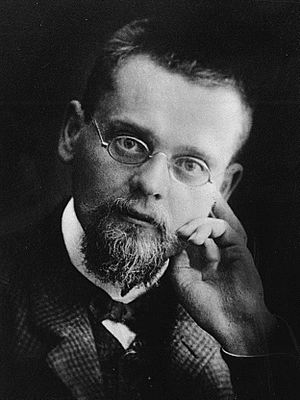Ernst Zermelo facts for kids
Quick facts for kids
Ernst Zermelo
|
|
|---|---|

Ernst Zermelo in the 1900s
|
|
| Born | 27 July 1871 |
| Died | 21 May 1953 (aged 81) |
| Nationality | German |
| Alma mater | University of Berlin |
| Known for |
|
| Spouse(s) | Gertrud Seekamp (1944 - death) |
| Awards | Ackermann–Teubner Memorial Award (1916) |
| Scientific career | |
| Fields | Mathematics |
| Institutions | University of Zürich |
| Doctoral advisor | |
| Doctoral students | Stefan Straszewicz |
Ernst Friedrich Ferdinand Zermelo (born July 27, 1871 – died May 21, 1953) was a German mathematician and logician. He is famous for his important work on the basic rules of mathematics. He helped create something called Zermelo–Fraenkel axiomatic set theory. This is a way to build math using a set of clear rules. He also proved the well-ordering theorem, which is a big idea in math.
Contents
Life and Education
Ernst Zermelo finished high school in Berlin in 1889. After that, he studied mathematics, physics, and philosophy at several universities. These included the University of Berlin, the University of Halle, and the University of Freiburg.
In 1894, he earned his doctorate degree from the University of Berlin. His main project was about a math topic called the calculus of variations. Zermelo stayed at the University of Berlin and worked as an assistant to Max Planck, a famous physicist. Under Planck's guidance, Zermelo started to study how liquids move, a field called hydrodynamics.
In 1897, Zermelo moved to the University of Göttingen. At that time, Göttingen was a top place for math research around the world. He completed his "habilitation thesis" there in 1899. This is a special paper that allows someone to teach as a professor in Germany.
In 1910, Zermelo became a professor of mathematics at Zurich University. He left this job in 1916. Later, in 1926, he was given an honorary professor position at the University of Freiburg. However, he quit this position in 1935 because he did not agree with Adolf Hitler's government. After World War II ended, Zermelo asked to be given his honorary position back in Freiburg, and he was.
Research in Set Theory
In 1900, a famous mathematician named David Hilbert presented a list of 23 unsolved math problems. He challenged mathematicians to solve them in the new century. The first problem was about set theory, which deals with collections of objects. This problem was called the continuum hypothesis. Hilbert also mentioned that mathematicians needed to prove the well-ordering theorem.
Zermelo became interested in set theory because of Hilbert. In 1902, he published his first paper on adding very large numbers called "transfinite cardinals." He also found a problem in set theory known as the Russell paradox.
In 1904, Zermelo made a big step towards solving Hilbert's first problem. He proved the well-ordering theorem, which states that "every set can be well ordered." This means you can arrange the items in any collection in a specific order. This proof made Zermelo famous, and he became a professor in Göttingen in 1905.
Not all mathematicians accepted his proof right away. This was because it used something called the axiom of choice. This axiom is a rule that allows you to pick an item from many collections, even if you don't know exactly what the items are.
In 1908, Zermelo created a better proof for the well-ordering theorem. This new proof was more widely accepted. In the same year, he also created a system of rules, or axiomatization, for set theory. This was a way to build set theory on a solid foundation of clear rules.
Zermelo started creating these rules for set theory in 1905. He published his results in 1908, even though he couldn't prove that his system of rules would never lead to contradictions.
Later, in 1922, two other mathematicians, Abraham Fraenkel and Thoralf Skolem, improved Zermelo's system of rules. The new system, which has 8 rules, is now called the Zermelo–Fraenkel axioms (ZF). It is the most common system used for axiomatic set theory today.
In 1931, Zermelo proposed a classic math problem called Zermelo's navigation problem. Imagine a boat traveling from one point to another on water. The boat has a maximum speed. The problem is to figure out the best way to steer the boat to reach its destination in the shortest possible time.
If there are no outside forces like current or wind, the best way is to steer the boat straight towards the destination. But if there is current or wind, steering straight might not be the fastest way. Zermelo's problem helps figure out the best path when these forces are present.
Images for kids
See also
 In Spanish: Ernst Zermelo para niños
In Spanish: Ernst Zermelo para niños
- Axiom of choice
- Axiom of infinity
- Axiom of limitation of size
- Axiom of union
- Boltzmann brain
- Choice function
- Cumulative hierarchy
- Pairwise comparison
- Von Neumann universe
- 14990 Zermelo, asteroid



